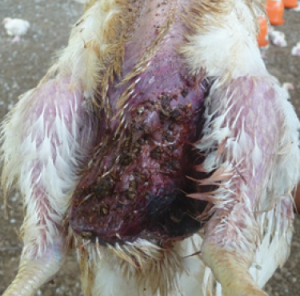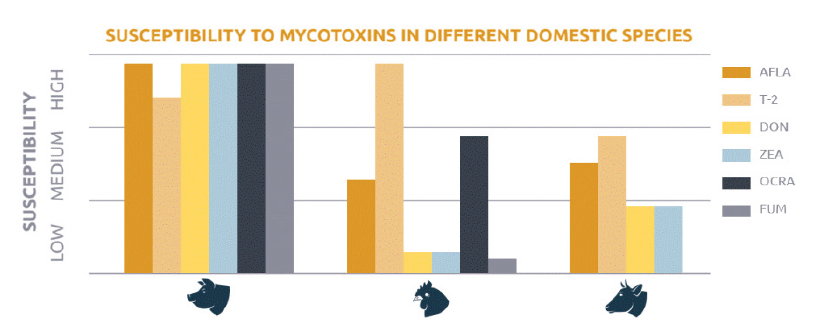In recent years, more attention has been paid to several types of toxins that frequently affect global animal production. Toxic substances—such as endotoxins, enterotoxins, exotoxins, and mycotoxins—are typically reported under field conditions and associated with animal health problems. Originating from various bacteria and fungi, the importance of understanding these toxins and their effects is crucial for developing strategies to mitigate their harm and ensure the well-being of individuals and the safety of food production systems. As a result, companies manufacturing feed additives have developed new products to counteract their harmful effects.
Also known as lipopolysaccharides (LPS), and only present in gram-negative bacteria, endotoxins represent the main structural components of the outer membrane (Figure 1). Endotoxins are the only type of toxin covered in this article not secreted by the bacterium. Instead, endotoxins are a consequence of bacterial cell destruction (lysis), mainly in the gastrointestinal tract. The liberation of LPS will induce an anti-inflammatory response in the host.

Figure 1: The outer membrane of a gram-negative bacterium
Treatment with antimicrobials, destruction by white blood cells (host defense mechanism), and/or the normal bacterial growth inside the host will contribute to the release of LPS. When animals are stressed by environmental conditions or management practices—such as extreme heat or, in the case of sows, labor in the farrowing stall—the intestinal microflora balance will be disrupted and result in a higher concentration of endotoxins. Once free in the intestines, they are absorbed and transferred to the bloodstream and stimulate the immune system. In the environment, endotoxins eliminated through the feces will mix with air and become part of the aerosol circulating inside the production facilities. Since endotoxins are part of the environment, caretakers will inhale them, and their presence will be detected in the blood.
Consisting of proteins that target the intestines, enterotoxins are released by both gram-negative and gram-positive bacteria. There are several types, and some enterotoxin-producing bacteria are very important in public health. One of the most common causes of diarrhea in the human population around the globe is the gram-negative bacterium, enterotoxigenic Escherichia coli O157:H7. On the other hand, some strains of the gram-positive bacteria Staphylococcus aureus are the etiologic agents of food poisoning because of contaminated foodstuff. In animal production, gram-positive bacteria such as Clostridium perfringens (CP) can produce enterotoxins, as well as exotoxins.
Also produced by gram-negative and gram-positive bacteria, exotoxins are a group of soluble proteins secreted in tiny amounts that are sometimes extremely lethal. The toxic effect of the enterotoxins produced by Clostridium will depend on the species and strains involved. For example, C. botulinum is the most toxic exotoxin producer in this group and C. tetani manufactures a strong toxin responsible for the clinical signs of tetanus in humans and animals.
There are three known strains of CP—types A (α toxin producer), C (β and α toxin producer), and G (NetB toxin producer)—that can cause clinical necrotic enteritis (NE). Besides producing exotoxins, CP types A and C also secrete enterotoxins during sporulation (highly resistant dormant forms of a bacterium) and are responsible for poultry-related foodborne diseases in humans. In poultry, CP is considered a normal constituent of the intestinal microflora. In healthy chickens, the CP population in the small intestines is less than 102–104 CFU (colony forming units)/g of feces. In birds affected by NE from CP, the concentration elevates to 107–109 CFU/g.
Historically, CP-α toxin was considered the main cause of intestinal damage. However, recent research has shown that CP-β, and CP NetB toxins are also responsible for the disease. Currently, there are commercial poultry vaccines against NE that include some of these toxins.
After CP is ingested by the bird, it will attach to the villi tip (intestines) during the first stage of the infection. Once located there, toxin production will start, and the enterocytes present in the intestinal wall will be damaged. C. perfingens may also gain access to the portal circulation (blood transported from the intestines to the liver) and move to the biliary ducts inside the liver and develop one of the most typical lesions identified in birds affected by NE, called cholangiohepatatis (inflammation of the gall bladder and adjacent hepatic tissue).
Gangrenous dermatitis (GD) is another disease associated with exotoxins produced by CP and C. septicum. S. aureus has also been isolated in birds affected by this condition.

Figure 2: Skin lesions in a commercial broiler chicken affected with gangrenous dermatitis
The often-unavoidable fungal contamination of grains is a growing concern because molds often produce toxic metabolites known as mycotoxins. This contamination can occur in the crops, during harvest and storage, or even after the feed is manufactured. Depending on the species, age, as well as the nutritional and health status at the time of exposure, mycotoxins can also cause a wide variety of deleterious effects in animal production. Some of the damages include teratogenic, mutagenic, immunosuppressive, and carcinogenic effects.

There are several different mycotoxins, with some affecting specific target organs present in the urinary, digestive, nervous, and reproductive systems. Mycotoxins typically come from the genera Fusarium, Penicillium, Aspergillus and each species then produces different mycotoxins with different modes of action. Hosts will try to reduce the toxicity of mycotoxins by breaking them down into metabolites. Frequently, this will reduce the toxic effects of the original mycotoxin, however, sometimes the result is the opposite. For example, Zearalenone (ZEA)—a mycotoxin with estrogenic activity—can be converted into two metabolites, α- zearalenol (500 times more estrogenic than ZEA) or β- zearalenol (16 times less estrogenic than ZEA).
Microbial toxins such as endotoxins, enterotoxins, and exotoxins pose substantial risks to animal and human well-being. Endotoxins result from the destruction of gram-negative bacteria to initiate inflammation, enterotoxins contaminate food and cause food poisoning, and exotoxins are highly lethal proteins. Additionally, mycotoxins from fungal contamination in grains add further concerns. By studying these toxins, we can develop strategies to mitigate their impact, enhance animal welfare, and ensure food safety.
Would you like to be kept informed of our latest developments? Register here and stay up to date.
"*" indicates required fields
| Cookie | Duration | Description |
|---|---|---|
| cookielawinfo-checkbox-analytics | 11 months | This cookie is set by GDPR Cookie Consent plugin. The cookie is used to store the user consent for the cookies in the category "Analytics". |
| cookielawinfo-checkbox-functional | 11 months | The cookie is set by GDPR cookie consent to record the user consent for the cookies in the category "Functional". |
| cookielawinfo-checkbox-necessary | 11 months | This cookie is set by GDPR Cookie Consent plugin. The cookies is used to store the user consent for the cookies in the category "Necessary". |
| cookielawinfo-checkbox-others | 11 months | This cookie is set by GDPR Cookie Consent plugin. The cookie is used to store the user consent for the cookies in the category "Other. |
| cookielawinfo-checkbox-performance | 11 months | This cookie is set by GDPR Cookie Consent plugin. The cookie is used to store the user consent for the cookies in the category "Performance". |
| viewed_cookie_policy | 11 months | The cookie is set by the GDPR Cookie Consent plugin and is used to store whether or not user has consented to the use of cookies. It does not store any personal data. |
